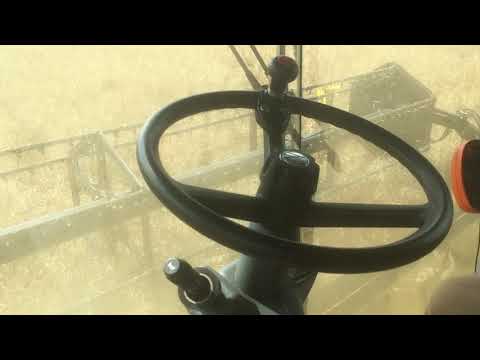Hi all!
Been away for a while but starting to ease myself back in to the scene ![]()
Thought I’d share a few photos and notes of my install on a Claas Lexion 630 Montana. While I’m sure these notes will apply to most Lexions, of course your mileage may vary.
I am using a Miran WY-01 linear sensor for steer sensing. This is uncompensated for Ackermann, which doesn’t cause a huge problem but it would be nice to fix it in software one day. The sensor is mounted to the ram with a 60mm exhaust clamp and a 25mm pipe clamp.
The valve is an old one, an Atos 4 way proportional piped directly in to the main block. This combine does have load sensing, however an assumption I can make is that when harvesting, the system will always be at full pressure due to the chaff spreader and reel hydraulic motors. This saves a lot of bother!
It’s handy that the steering lines are tee’d in a convenient location from the factory, directly above the block. When connecting to the main block, I chose to use the plugged ports on the very bottom. I had real trouble finding matching connectors, however after some digging it turns out they are ISO 6149. When opening the block be prepared for a heavy flow from the T port! Disconnect the main return pipe at the hydraulic tank in the engine bay to prevent siphoning.
The wiring was brought into the cab through a gland into the main electrical box. I was concerned about noise on the analog steer signal, however looking at it on the scope it’s remarkably clean. An update will be to place an ADC on the rear axle and then implement a OneWire bus back to the cab. (So I can use the existing wiring and because it is a very robust protocol)
In the cab I am using a Chuwi Ubook Pro. This 12.3 inch tablet is actually very capable and well built, and the fanless design is ideal, and it charges on 12v. Connection over USB to the arduino, Ardusimple RTK2B Lite and a Sierra MC7700 modem.
I am using a single antenna with BNO080 IMU for heading and roll. It’s the same silicon as the maligned BNO055, but with much improved software from Hillcrest, so it is rock stable. I thought I might be able to get away without an IMU because of self levelling, however this only ends up in a fight between the autosteer and the levelling, and one seasick operator. The levelling does not cause offset issues as the wheels themselves are raised/lowered, preserving the centerline of the machine.
The arduino is running my custom .ino, and because I haven’t ported it to the new version, I am still running AOG v309. The main features are button on/off for autosteer and the BNO080 code. I take quaternions from the chip over I2C and convert them to yaw and roll angles, then massage them to the correct format for AOG. I have disabled the kalman filter because the BNO080 is very well filtered already. See my other thread on the pinmapping of the combine handle for discussion of taming the combine’s signal to arduino-friendly signals.
My photos are too large to fit on this forum so have a google album instead: https://photos.app.goo.gl/Rz9PUYwR7wX2pDU16
Hope someone finds this helpful!

